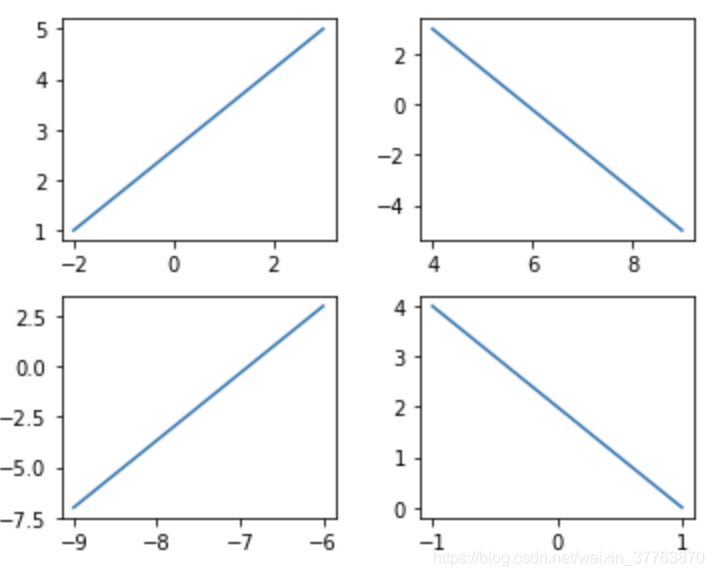Matplotlib |
您所在的位置:网站首页 › pythonmatplotlibsubplot › Matplotlib |
Matplotlib
|
文章目录
1.多图合一(subplot)2.分格显示2.1.subplot2grid方法2.2.gridspec方法2.3.subplots方法
3.图中有图(plot in plot)4.设置双坐标轴
1.多图合一(subplot)
matplotlib 是可以组合许多的小图, 放在一张大图里面显示的. 使用到的方法叫作 subplot. 使用import导入matplotlib.pyplot模块, 并简写成plt. 使用plt.figure创建一个图像窗口. 使用plt.subplot来创建小图. plt.subplot(2,2,1)表示将整个图像窗口分为2行2列, 当前位置为1. 使用plt.plot([-2,3],[1,5])在第1个位置创建一个小图.依此类推后面三个子图。 import matplotlib.pyplot as plt plt.figure(figsize=(5,4)) plt.subplot(2,2,1) #221亦可 plt.plot([-2,3],[1,5]) plt.subplot(2,2,2) plt.plot([4,9],[3,-5]) plt.subplot(2,2,3) plt.plot([-6,-9],[3,-7]) plt.subplot(2,2,4) plt.plot([1,-1],[0,4]) plt.tight_layout() #自动调整子批次参数,使子批次适合图形区域
使用plt.subplot2grid来创建第1个小图, (3,3)表示将整个图像窗口分成3行3列, (0,0)表示从第0行第0列开始作图,colspan=3表示列的跨度为3, rowspan=1表示行的跨度为1. colspan和rowspan缺省, 默认跨度为1.后面子图与此方法一样。 import matplotlib.pyplot as plt plt.figure() ax1 = plt.subplot2grid((3, 3), (0, 0), colspan=3) #plt.subplot2grid(shape, location, rowspan, colspan) ax1.plot([1.6, 2.3], [0.8, 1.2]) #画直线 ax1.set_title('this is ax1') ax2 = plt.subplot2grid((3, 3), (1, 0), colspan=1) #起始(1,0)横向跨度为1 ax3 = plt.subplot2grid((3, 3), (1, 2), rowspan=2) #起始(1,2)纵向跨度为2 ax4 = plt.subplot2grid((3, 3), (2, 0)) ax4.scatter([0.5, 1], [1.8, 1.5]) ax4.set_xlabel('X') ax4.set_ylabel('Y') ax5 = plt.subplot2grid((3, 3), (2, 1)) plt.tight_layout() plt.show()
使用import导入matplotlib.pyplot模块, 并简写成plt. 使用import导入matplotlib.gridspec, 并简写成gridspec. 使用plt.figure()创建一个图像窗口, 使用gridspec.GridSpec将整个图像窗口分成3行3列. 使用plt.subplot来作图, gs[0, :]表示这个图占第0行和所有列, gs[1, :2]表示这个图占第1行和第2列前的所有列, gs[1:, 2]表示这个图占第1行后的所有行和第2列, gs[-1, 0]表示这个图占倒数第1行和第0列, gs[-1, -2]表示这个图占倒数第1行和倒数第2列. import matplotlib.pyplot as plt import matplotlib.gridspec as gridspec plt.figure() gs = gridspec.GridSpec(3, 3) # use index from 0 ax6 = plt.subplot(gs[0, :]) ax7 = plt.subplot(gs[1, :2]) ax8 = plt.subplot(gs[1:, 2]) #第一行第二行的第二列(起始为0) ax9 = plt.subplot(gs[-1, 0]) #最后一行第一个位置 ax10 = plt.subplot(gs[-1, -2]) #最后一行倒数第二个位置 plt.tight_layout() plt.show()
使用plt.subplots建立一个2行2列的图像窗口,sharex=True表示共享x轴坐标, sharey=True表示共享y轴坐标. ((ax11, ax12), (ax13, ax14))表示第1行从左至右依次放ax11和ax12, 第2行从左至右依次放ax13和ax14. 使用ax11.scatter创建一个散点图. import matplotlib.pyplot as plt f, ((ax11, ax12), (ax13, ax14)) = plt.subplots(2, 2, sharex=True, sharey=True) ax11.scatter([1.3,1.75], [1.8,1]) plt.tight_layout() #表示紧凑显示图像 plt.show()
首先确定大图左下角的位置以及宽高:left, bottom, width, height = 0.1, 0.1, 0.8, 0.8 注意,4个值都是占整个figure坐标系的百分比。在这里,假设figure的大小是10x10,那么大图就被包含在由(1, 1)开始,宽8,高8的坐标系内。 将大图坐标系添加到figure中,颜色为r(red),取名为title。 接着,我们来绘制右上角的小图,步骤和绘制大图一样,注意坐标系位置和大小的改变: import matplotlib.pyplot as plt fig = plt.figure() #定义一个图像窗口 x = [2, 3, 2, 5, 4, 8, 7] y = [2, 5, 6, 8, 2, 3, 1] left, bottom, width, height = 0.1, 0.1, 0.8, 0.8 #left、bottom为原点坐标(按比例),width, height为图的长宽(按比例) ax1 = fig.add_axes([left, bottom, width, height]) #在fig中添加一个图 ax1.plot(x, y, 'blue') ax1.set_xlabel('x') ax1.set_ylabel('y') ax1.set_title('title') left, bottom, width, height = 0.6, 0.6, 0.25, 0.25 ax2 = fig.add_axes([left, bottom, width, height]) #在fig中再添加一个图 ax2.plot(y, x, 'r') ax2.set_xlabel('x') ax2.set_ylabel('y') ax2.set_title('small fig in large ') plt.show()效果如下: 有时候我们会用到次坐标轴,即在同个图上有第2个y轴存在。同样可以用matplotlib做到,而且很简单。 对ax1调用twinx()方法,生成如同镜面效果后的ax2 import matplotlib.pyplot as plt import numpy as np x = np.arange(0,10,0.1) y1 = 2*(x**2) y2 = -0.5*(x**2) fig, ax1 = plt.subplots() ax2 = ax1.twinx() #使用twinx添加y轴的坐标轴 ax1.plot(x, y1, 'g-') ax2.plot(x, y2, 'r+') #设置标签(共用X轴) ax1.set_xlabel('X') ax1.set_ylabel('Y1',color='g') ax2.set_ylabel('Y2',color='r') plt.show()
|
【本文地址】





